
|
Sale 74
June Long Beach Coin Auction
| Lot |
Photo |
Description |
Realized |
Lot 4343 |
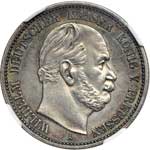 |
German States - Prussia. 2 Marks, 1884-A. KM-506; J-96a. Wilhelm I. NGC graded About Uncirculated, Details (Surface Hairlines).
Estimated Value $250 - 300.
View details and enlarged photos
| Realized
$207 |
Lot 4344 |
 |
German States - Prussia. 2 Marks, 1893-A. KM-522; J-102. Wilhelm II. Beautiful deep multi color toning. NGC graded MS-65.
Estimated Value $200 - 250.
View details and enlarged photos
| Realized
$207 |
Lot 4345 |
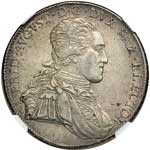 |
German States - Saxony. Taler, 1798-IEC. Dav-2701; KM-1036. Friedrich August III. Toned. NGC graded AU-55.
Estimated Value $150 - 200.
View details and enlarged photos
| Realized
$184 |
Lot 4346 |
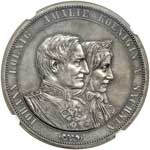 |
German States - Saxony. 2 Taler, 1872-B. Dav-899; KM-1231.1; Thun-352. Johann. For the Golden Wedding Anniversary. Light gray tone. NGC graded MS-61.
Estimated Value $150 - 175.
The George C. Follis Collection.
View details and enlarged photos
| Realized
$276 |
Lot 4347 |
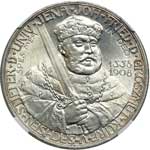 |
German States - Saxe-Weimar-Eisenach. 5 Marks, 1908-A. Dav-849; KM-220; J-161. Jena University 350th Anniversary. NGC graded MS-66.
Estimated Value $250 - 300.
The George C. Follis Collection.
View details and enlarged photos
| Realized
$506 |
Lot 4348 |
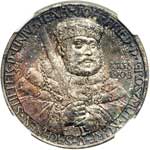 |
German States - Saxe-Weimar-Eisenach. 2 Marks, 1908-A. KM-219; J-160. Jena University 350th Anniversary. Toned. NGC graded MS-66.
Estimated Value $175 - 225.
View details and enlarged photos
| Realized
$299 |
Lot 4349 |
 |
German States - Württemberg. Taler, 1866. Dav-960; KM-615; Thun-440. Karl I. NGC graded AU-53.
Estimated Value $150 - 200.
View details and enlarged photos
| Realized
$150 |
Lot 4350 |
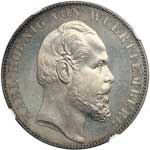 |
German States - Württemberg. Taler, 1871. Dav-962; KM-620; Thun-443. Karl I. Victorious Conclusion of Franco-Prussian War. NGC graded MS-65.
Estimated Value $200 - 250.
View details and enlarged photos
| Realized
$414 |
Lot 4351 |
 |
German States - Württemberg. 3 Mark, 1911-F. KM-636; J-177a. Wilhem II. Silver Wedding Anniversary. PCGS graded Proof 64.
Estimated Value $125 - 175.
View details and enlarged photos
| Realized
$253 |
Lot 4352 |
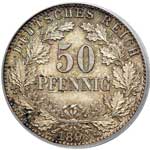 |
Germany. 50 Pfennig, 1896-A. KM-15; J-15. Scarce type. Attractive original toning. PCGS graded MS-64.
Estimated Value $400 - 500.
View details and enlarged photos
| Realized
$483 |
Lot 4353 |
 |
Germany. 1 Mark, 1911-E. KM-14; J-17. Beautifully toned. NGC graded MS-67.
Estimated Value $100 - 150.
View details and enlarged photos
| Realized
$104 |
Lot 4354 |
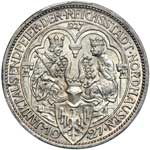 |
Germany. 3 Reichsmark, 1927-A. KM-52; J-327. For the 1000th Anniversary - Founding of Nordhausen. PCGS graded MS-63.
Estimated Value $175 - 225.
View details and enlarged photos
| Realized
$184 |
Lot 4355 |
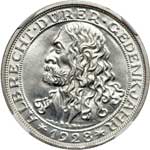 |
Germany. 3 Reichsmark, 1928-D. KM-58; J-332. For the 400th Anniversary - Death of Albrecht Durer. NGC graded MS-64.
Estimated Value $500 - 600.
View details and enlarged photos
| Realized
$391 |
Lot 4356 |
 |
Germany. 3 Reichsmark, 1931-A. KM-73; J-348. Centenary - Death of von Stein. NGC graded MS-64.
Estimated Value $175 - 200.
View details and enlarged photos
| Realized
$115 |
Lot 4357 |
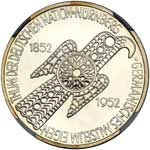 |
Germany. 5 Marks, 1952-D. KM-113; J-388. Centenary - Nurnberg Museum. Mintage 1,240 proofs. NGC graded Proof 64 Cameo.
Estimated Value $1,500 - 2,000.
View details and enlarged photos
| Realized
$1,840 |
Lot 4358 |
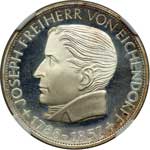 |
Germany. 5 Marks, 1957J. KM-117; J-391. Joseph Von Eichendorff. NGC graded Proof 64 Ultra Cameo.
Estimated Value $500 - 600.
The George C. Follis Collection.
View details and enlarged photos
| Realized
$483 |
Lot 4359 |
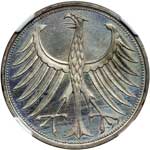 |
Germany. 5 Marks, 1957-J. KM-112.1; J-387. NGC graded Proof 64 Cameo.
Estimated Value $400 - 500.
The George C. Follis Collection.
View details and enlarged photos
| Realized
$184 |
Lot 4360 |
 |
Germany. 1 Mark, 1957-J. KM-110; J-385. Mintage 200. NGC graded Proof 66 Cameo.
Estimated Value $300 - 350.
The George C. Follis Collection.
View details and enlarged photos
| Realized
$184 |
Lot 4361 |
 |
Germany. 2 Mark, 1957-J. KM-116; J-392. Mintage 370. NGC graded Proof 67 Cameo.
Estimated Value $150 - 200.
The George C. Follis Collection.
View details and enlarged photos
| Realized
$127 |
Lot 4362 |
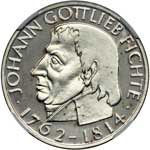 |
Germany. 5 Mark, 1964-J. KM-118.1. Johann Gottlieb Fichte. NGC graded Proof 65 Cameo.
Estimated Value $500 - 700.
View details and enlarged photos
| Unsold |
Lot 4363 |
|
Germany. Miscellaneous lot of Crowns and Minors: Lot includes Thun talers, Empire 2,3 and 5 marks, Kiau Chau 5 and 10 Cents, 1909; plus miscellaneous minors. Careful examination recommended. Sold as is, no returns. Lot of 20 coins. Fine to Extremely Fine.
Estimated Value $350 - 400.
The George C. Follis Collection.
View details
| Realized
$661 |
Lot 4364 |
|
Germany. Group of Certified State Minors: Bavaria. Kreuzer, 1856. KM-799. PCGS graded MS-65; Prussia. 2 Marks, 1901A. KM-525; J-105. Bicentennial. NGC graded MS-65; Prussia. 2 Marks, 1913A. KM-532; J-109. Defeat of Napoleon. NGC graded MS-64; Saxony. 3 Marks, 1913E. KM-1275; J-140. Leipzig. NGC graded MS-65. Lot of 4 coins.
Estimated Value $150 - 200.
View details
| Realized
$242 |
Lot 4365 |
|
Germany. Pair of Talers: Bavaria. 2 Gulden, 1855. Dav-600; T-90; KM-828. NGC graded AU 53; Saxony. Taler, 1865B. Dav-898; T-348; KM-1214. NGC graded AU 50. Lot of 2 coins.
Estimated Value $150 - 200.
View details
| Realized
$230 |
Lot 4366 |
|
Germany. Lot of Certified Coins: Baden. 2 Mark, 1903G. KM-272. PCGS MS 62; Bavaria. 2 Mark, 1911D. KM-997. NGC MS 63; Bremen. Taler, 1871B. KM-249. PCGS MS 62; Frankfurt. Ducat in silver, 1742. KM-PN39. NNC AU 58; Prussia. 2 Mark, 1888A. KM-510. NGC MS 63; Saxony. 3 Mark, 1913E. KM-1275. NGC MS 63; Weimar Republic. 3 Mark, 1922G. KM-29. PCGS MS 65. Lot of 7 coins.
Estimated Value $400 - 500.
View details
| Realized
$690 |
Lot 4367 |
|
Germany. Pair of Choice Certified 2 Marks: Prussia. 2 Mark, 1913A. KM-532; J-109. Defeat of Napoleon; Saxony. 2 Mark, 1909. KM-1268; J-138. 500th Anniversary - Leipzig University. Lot of 2 coins. NGC graded Both pieces, MS-66.
Estimated Value $200 - 250.
View details
| Realized
$207 |
Lot 4368 |
|
Germany. Lot of Certified Proof's: Bavaria. 3 Marks, 1911D. KM-998. 90th Birthday. PCGS graded Proof 64; Prussia. 2 Marks, 1913A. KM-532. Victory over Napoleon. NGC graded Proof 63; Prussia. 3 Marks, 1913A. KM-534. Victory over Napoleon. PCGS graded Proof 61 Cameo. Lot of 3 coins.
Estimated Value $300 - 400.
View details
| Realized
$345 |
Lot 4369 |
|
Germany. Lot of 5 Reichsmarks, 1934-1939. KM-83 (18 pieces), 86 (27 pieces), 94 (29 pieces). Total weight 29.7184 ounces. Lot of 74 coins. Very Fine to About Uncirculated.
Estimated Value $600 - 700.
The Dr. Charles Ruby Estate.
View details
| Realized
$863 |
Lot 4370 |
|
Germany. Lot of 2 Reichsmarks, 1936-1939. KM-93. Silver. Weight 0.1607 ounce per coin. Swastika-Hindenburg issue. Lot of 66 coins. Fine to Very Fine.
Estimated Value $225 - 275.
View details
| Realized
$374 |
Lot 4371 |
|
Germany. Accumulation of Talers and Minors: This lot contains talers, 2,3, 5 Marks and minors from the 1750's to the 1930's. We strongly recommend careful examintion. Sold as is, no returns. Lot of 120 coins.
Estimated Value $1,500 - 1,800.
View details
| Realized
$3,450 |
Lot 4372 |
|
Germany. Large Accumulation of Minors from the 1800's to 1970's. Lot includes several silver coins (2,3,5 Marks) modern issues, and tokens. Careful examination recommended. Gross weight of lot 8 ½ pounds. Sold as is, no returns.
Estimated Value $600 - 700.
View details
| Realized
$1,150 |
Lot 4373 |
|
Germany. Lot of Munich Olympic 10 Marks, 1972. KM-133-135. Silver. Weight 0.3114 ounce per coin. Lot of 61 coins. Almost Uncirculated to Uncirculated.
Estimated Value $400 - 500.
View details
| Realized
$426 |
Lot 4374 |
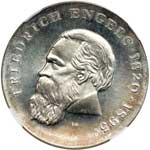 |
German Democratic Republic. 20 Mark, 1970. KM-28. 150th Anniversary - Birth of Friedrich Engels. NGC graded MS-65.
Estimated Value $100 - 125.
View details and enlarged photos
| Realized
$63 |
Lot 4375 |
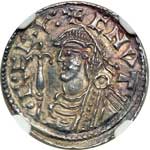 |
Great Britain. Penny, ND. S.1159. Cnut, 1016-1035. Lincoln mint. Moneyer, Godric. Practically mint state with a light tone, well centered on a good sized flan. All lettering well struck up. An exceptionally nice example. NGC graded AU-55.
Estimated Value $800 - 900.
View details and enlarged photos
| Realized
$863 |
Lot 4376 |
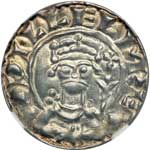 |
Great Britain. Penny, ND. S.1257. William I, The Conqueror, 1066-1087. PAXS type. Lincoln mint. Moneyer, Minter Siferth. A lovely round coin, virtually as struck with a light tone and all detail well struck up. A great specimen. NGC graded AU-58.
Estimated Value $1,300 - 1,400.
View details and enlarged photos
| Unsold |
Lot 4377 |
 |
Great Britain. Groat, ND. S2157. N1679. Richard III, 1483-1485. Type III in Richard's name. Mint mark halved sun and rose. Obverse stylized though distinctive portrait of king facing. Reverse, long cross, quartering coin. Practically uncirculated with stunning facial detail on the portrait. Deep blue/gray toning with shades of aquamarine on the reverse. Flan a little uneven, but more round than most extant specimens. A superb example of the largest silver coin of Britain's most controversial monarch. Very rare, and especially so in this high grade. NGC graded EF-45.
* Richard III was king for only 2 years (1483-1485) and his body was discovered in 2012 under a car park in Leicester, not far from where he fought his last battle at Bosworth Field on 22 August 1485.
Richard III had the misfortune to attract the attention of 2 men of literary genius, Sir Thomas More and William Shakespeare. The former held up Richard for examination in the light of the new Renaissance learning, as a model of what a king should not be, while Shakespeare drew on More and other Tudor chroniclers, to produce a piece of propaganda which also happened to be a very entertaining work of art.
As the brother of King Edward IV who reigned 1461-1470 to 1483 (with a brief interruption 1470-71) Richard fought loyally by his side. Around him raged factional quarrels and duplicity. In 1477 the machinations of another brother, the oft-forgiven Duke of Clarence, became too much even for the tolerant King Edward. Clarence was sentenced to death for high treason and while Edward hesitated to implement the sentence, Parliament (the Commons) urged that he be killed. It seems likely that Clarence really was drowned in a barrel of Malmsey wine as celebrated in Shakespeare's play 'Richard III.' It was his favourite tipple, and it seems that Clarence was allowed to choose his own style of death. According to contemporary chroniclers (as opposed to Tudor ones) Richard's voice was the only one to speak up for Clarence, and after his brother's death he was so overcome by grief that 'Thenceforth Richard came rarely to court and he kept himself within his own lands. The good reputation of his private life and public activities powerfully attracted the esteem of strangers.' This good contemporary account of Richard's private life is in sharp contrast to Shakespeare's vilification. The picture of Richard which can be gleaned from the comments and records before he became king, and before the Tudor writers went to work on him, is by no means detailed but we get a picture of a man who was reserved, serious, loyal, and almost puritanical in his devotion to business matters.
On the death of Edward IV, Richard was established as Protector of Edward's 12 year old son (also named Edward) who would have been crowned King Edward V. The powerful nobleman Lord Hastings initially supported this course of events, but then switched allegiance to Edward IV's widow Elizabeth Woodville, who fled with her younger son Richard and her daughters, and sought sanctuary in Westminster Abbey. Richard's reaction was as fast as the attempt to seize power by Elizabeth and Hastings had been. Richard had Hasting's executed and removed the two young princes to the Tower of London. At this stage it should be noted that the Tower was still regarded as a royal residence and had not yet acquired its sinister reputation as a prison. But the princes did eventually disappear.
Richard was declared King and was crowned at Westminster Abbey in June 1483. He set out to tour his kingdom, but he soon received news of a switch of allegiance by the Duke of Buckingham to the alliance which focused on Elizabeth Woodville and Henry Tudor.
As an exile in France, Henry Tudor had his eyes on the English crown and basked in new rumours that not only had King Richard ordered the murders of the two Princes in the Tower, but those of King Henry VI and the Duke of Clarence! Henry landed on August 7th in Milford Haven, Wales and gradually gathered an army which confronted Richard at Bosworth, two weeks later. It seems that Richard, accompanied by 80 devoted followers, charged straight at Henry, but this rash battle tactic backfired and he was overwhelmed and hacked to death.
The discovery of Richard's body after 527 years will do nothing to tell us who killed the princes in the Tower, or to what extent the Tudors' vilification of Richard was justified, but it does confirm Richard's manner of death. Interestingly, it also tells us that he was not as deformed as Shakespeare would have us believe. Richard had a sideways twisted spine which resulted from scoliosis and this caused one shoulder to be a little higher than the other, but he did not have a withered arm and he was slightly taller than the average height for the period. The supporters of Richard now hope that the image of the able administrator and loyal brother can supplant that of the evil deformed usurper so popular in Tudor England!
Estimated Value $5,500 - 6,500.
View details and enlarged photos
| Realized
$6,613 |
Lot 4378 |
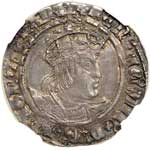 |
Henry VIII (1509-1547), groat. . S-2316. Second Coinage, 1526-44. Young portrait of Henry VIII facing right. Reverse: Quartered arms. Seaby 2337E. Well struck on a superior flan. Light antique gray toning and quite choice. NGC graded AU-55.
Estimated Value $300 - 400.
View details and enlarged photos
| Realized
$690 |
Lot 4379 |
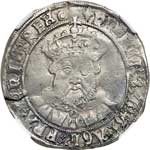 |
Great Britain. Testoon or Shilling, ND. S.2365. Henry VIII, 1509-1547. London mint. Third coinage (1544-1547). Obverse: Classic crowned portrait of king facing. Reverse: Crowned rose between crowned H and crowned R. This is the very first English shilling coin. Produced as a new denomination towards the end of this remarkable reign, the coins were poorly made and sometimes turn up with the portrait and design barely visible. This is actually a superb example, and although it has a small edge striking split (as is often the case) it has probably seen little if any circulation. It has a great portrait, with well struck features and the image of bluff King Henry, the serial divorcer and thorn in the side of the Catholic Church is very similar to that seen in a Holbein painting! Very high grade for this crude issue. NGC graded EF-40.
*This piece appears to be made from good metal and has a bright, high-grade silver appearance. Unfortunately many Testoons were minted from low-grade silver and have a tell-tale greeny-gray look. Henry VIII openly debased the coinage from 1544 to help finance his wars, and between 1544 and 1546 the silver content of his coins declined by nearly 60%. In the end the quality of England's silver coinage was so poor that the blanched silver surface of the coins soon wore away to reveal the copper alloy beneath, which earned Henry the nickname 'Old Coppernose.'
The last five years of Henry's reign (1542-1547) were almost as gloomy as his father's (Henry VII) had been. He suffered from severe headaches which were growing worse, and an ulcerous leg which caused him great pain. At the relatively young age of 53 he was so obese he was virtually immobile. He obtained some consolation from his last marriage in 1543 to the twice-widowed Catherine Parr, an intelligent woman who nursed her ailing spouse and provided some semblance of normal family life for him. Catherine persuaded Henry to have all of three children at court, Mary and Elizabeth as well as the beloved Edward. Henry made another incursion into France, which merely drained the English exchequer of money skillfully accrued by Thomas Cromwell, and led, among other things, to the debasement of the coinage. Henry died an ageing, obese, capricious tyrant in January 1547, having ascended the throne 38 years earlier in a burst of enthusiasm, a swaggering, tall and talented young man, full of promise and potential. History remembers Henry VIII for his 6 wives and the fact that he led England in a break with the Catholic Church of Rome.
Estimated Value $6,500 - 7,000.
View details and enlarged photos
| Unsold |
Lot 4380 |
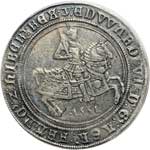 |
Great Britain. Crown, 1551. S.2478; Dav-8245. Edward VI, 1547-1553. Fine Silver issue. King on horseback, right, date below. The first dated English coin! Reverse: Long cross quarters shield of arms. Well struck design, nicely centered and with a good edge. Lightly toned, and a lovely large flan. The remarkable Slaney collection had a sharper specimen than this, but it sold for some 42,000 British Pounds (about $76,000 at the time). Most examples of the Edward VI silver Crown are around Fine in grade, and may are worse. In our opinion conservatively graded. PCGS graded VF-35.
This compares well with the Cheshire Collection specimen where the coin's background was described as this: 'King Edward (the third Tudor king) was only 14 when this coin was minted, son of Henry VIII by Jane Seymour, in fact Henry's only son. Henry's obsessive desire for a male heir of course caused the great schism between the catholic church and himself, leading to the establishment of the Church of England. Edward's health had been fragile since birth, and he died of tuberculosis in July 1553. He had no time to make his mark on the world, except perhaps, numismatically, for his coins are classic works of Renaissance art, and this, his silver crown, became the very first in a long line of beautifully engraved, emblematic, large silver issues of England and later Great Britain.
Estimated Value $7,000 - 8,000.
View details and enlarged photos
| Unsold |
Lot 4381 |
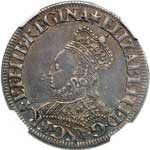 |
Great Britain. Milled Shilling, ND. S.2592. Elizabeth I, 1558-1603. Milled issue. Mint mark, star. The small size issue, around 30 diameter. Nicely struck on a very even flan. The reverse has a proof-like quality, the obverse has nice blemish-free surfaces. A good looking example of this rare milled issue. NGC graded AU-55.
* These 'milled' coins were innovative, and were among the finest examples of Tudor numismatic art. For the next century the regular silver coinage was of inferior quality, especially during the period of the English Civil War. The early 'milled' coins were produced in a screw press introduced by Eloye Mestrelle, a French moneyer, only 3 years or so after Elizabeth I's accession. The machinery required to produce this new 'mill money' was slow and cumbersome (parts of the machinery were powered by a horse drawn mill) and producing coins by hand proved faster. Mestrelle was himself unpopular and was ironically hanged for counterfeiting in 1578. A sad end to a great man who was ahead of his time.
Estimated Value $3,000 - 3,500.
View details and enlarged photos
| Realized
$3,738 |
Lot 4382 |
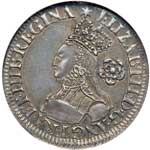 |
Great Britain. Milled Sixpence, 1562. S.2596. Elizabeth I, 1558-1603. Milled coinage. Mint mark, Star. Narrow bust with large rose to right. Reverse: Cross on shield. Sharply struck with reflective fields and lovely old toning. Rare in this top grade. NGC graded MS-61.
Estimated Value $1,500 - 1,800.
View details and enlarged photos
| Realized
$5,175 |
Lot 4383 |
 |
Great Britain. Crown, 1601. S.2582; Dav-3757. Elizabeth I, 1558-1603. Mint mark, 1. Obverse: Crowned portrait of Queen left. Reverse: Large shield of arms. Nicely toned, and a good size flan. This compares well with other Elizabeth I Crowns offered during the last few years. A handsome piece with none of the metal flaws, flan cracks or other striking irregularities which usually plague this impressive issue. NGC graded EF-45.
This coin was struck just a couple of years before the death of one of England's greatest monarchs. A firm pragmatist, Elizabeth had maintained peace within her kingdom, and she managed to avoid war with her neighbors. But by 1588 King Philip of Spain had decided to attack England and teach Elizabeth a lesson she would remember. England was a bastion of anti-Catholicism and Elizabeth had long provided a base and refuge for Philip's rebellious subjects in the Netherlands, but she was now supplying soldiers to fight alongside the Dutch. Once faced with the hated prospect of war, however, Elizabeth acted decisively.
The invading Spanish Armada, of which it was originally said 'the ocean sighed under the burden of it' was sighted off the coast of Cornwall on 19th July 1588 and the warning beacon fires flamed along the coast of southern England, alerting everyone to the defence of his native land. As the Armada had anchored off Calais for the night, Francis Drake sent in fire-ships, loaded with anything inflammable that could be found. The panicking fleet sailed north and was slowly decimated by the harrrying English and storms. The invasion failed.
It was during her reign that the foundations of the future British Empire were laid and here began England's association with America, indeed Virginia was named after Elizabeth I. She always appreciated that England was important as a jumping-off point for the New World.
In her last years, unlike other long-lived monarchs, Elizabeth did not lose her grip. She even contained her infatuation for the handsome Earl of Essex, a boy of 17 when he came to court, and 34 years her junior. In 1601 Essex dared to lead a rebellion against Elizabeth. He was executed on 30 November 1601, around the time this silver Crown was minted.
On March 24 1603 Elizabeth died. She was the last and greatest of the Tudors.
Estimated Value $12,000 - 14,000.
View details and enlarged photos
| Realized
$16,675 |
Lot 4384 |
 |
Great Britain. Crown, ND. S.2652; Dav-3759. James I, 1603-1625. Second coinage (1604-1619). Mint mark, lis (1604-1605). Obverse: King on horseback facing right, holding sword in right hand. Reverse: Ornate Stewart shield and motto: QVAE DEVS CONIVNXIT NEMO SEPARET ('that which God has joined together let no man separate' - a reference to the union of the thrones of Scotland and England). A good round coin and beautifully struck in every sharp detail, with the tiniest of surface and flan marks. It may have been smoothed in fields a long time ago, but this does not detract from the great detail and eye appeal. Almost mint sate with a pleasing dark tone, this is a major rarity and ranks at the top of the few high quality pieces known. In our opinion nicer than the Slaney collection specimen which fetched £9,200 British Pounds in May 2003, and certainly nicer than any of the four Van Roekel collection James I Second Coinage crowns which were offered in 2001. NGC graded Extremely Fine, Details (Tooled).
This crown was struck during the period 1604-1605 when the small lis mintmark was used on the coinage.
When James VI of Scotland succeeded to the English throne in 1603 upon the death of the popular Queen Elizabeth I, he had already achieved a reputation as a successful ruler as well as a scholar. It was with considerable anticipation then that the English awaited his arrival.
The early impressions of the new ruler who was to style himself the 'King of Great Britain,' were not favorable. James had never been an heroic figure, but his pallid countenance and limping figure were growing more prepossessing with age. His broad Scots accent and often clownish manners dismayed his courtiers. One Englishman commented, 'He is wonderfully clever,' but he added 'and he has an excellent opinion of himself.' To some extent James's self-confidence was justified. He had successfully managed his turbulent Scottish kingdom, but did not realize that England had a much rowdier and more demanding Parliament.
For the first few years of his reign James was carried along by Elizabeth's old ministers and notably Robert Cecil whom he created Earl of Shaftesbury in 1605. In 1605 he was also fortunate that a plot by a group of Catholic conspirators (including Guy Fawkes) was discovered before the gunpowder they had concealed below the Houses of Parliament could have 'blown up all at a clap.'
Perhaps James was lucky that he never had a major confrontation with Parliament before he died in 1625 aged fifty nine. His son Charles I was not so lucky.
Estimated Value $10,000 - 12,000.
View details and enlarged photos
| Realized
$10,638 |
Lot 4385 |
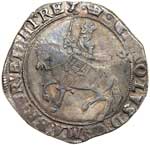 |
Great Britain. Halfcrown, ND. S.2773. Charles I, 1625-1649. Produced at the Tower mint under the King. Mint mark, Crown (1635-1636). Group III. Type 2a1. This is a remarkably well struck piece from an era when the coinage was crudely produced. Made around 6 or 7 years before the start of England's only civil war, it has survived intact! Practically as struck and attractively toned. NGC graded Extremely Fine, Details (Scratches).
Estimated Value $400 - 450.
View details and enlarged photos
| Realized
$575 |
Lot 4386 |
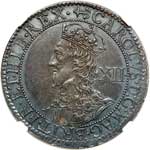 |
Great Britain. Shilling, ND. S.2859. Charles I, 1625-1649. Briot's second milled issue (1638-1639). Mint mark, anchor. Obverse portrait of king by Nicholas Briot with large lace collar of stellate pattern. XII (12 Pence) behind head as mark of value. Reverse cross moline over square topped shield of arms. Practically in mint state with dark blue tone and prooflike surfaces. Similar to the Slaney collection specimen (lot 50) which fetched £1500 plus buyer's premium in May 2003! A superb example and a pre-English Civil War Charles I numismatic delight. NGC graded AU-58.
Estimated Value $2,400 - 2,600.
View details and enlarged photos
| Realized
$3,450 |
Lot 4387 |
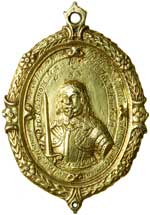 |
Great Britain. 1642 Earl of Essex, Military Reward Medal. Eimer-140a; MI i, 295/113. Cast, oval, 37mm x 53.5mm, in gilt metal (silver?), 11.9 grams, with integral loop for suspension. An English Civil War "roundhead" military award in the name of Robert Devereux, 3rd Earl of Essex (1591-1646), the first Commander-in-Chief of Parliamentary forces. Obv: Armored bust of Essex holding sword, legends around, within ornate wreathed border; Reverse: Views of Parliament in session. A later cast (as are all originals) likely 18th to mid-19th century, with an unknown maker punch mark at the top reverse of loop. Some very light old tooling in obverse fields. Very Fine.
Estimated Value $400 - 600.
View details and enlarged photos
| Unsold |
Lot 4388 |
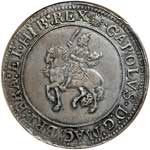 |
Great Britain. Crown, ND. S.2761. Charles I, 1625-1649. Tower mint under Parliament issue. Mint mark sun. Obverse, King Charles seated on a foreshortened horse, holding sword upright. Reverse, oval garnished shield with the royal arms and the motto CHRISTO AVSPICE REGNO ('I reign under the auspices of Christ'). Beautifully toned in pastel shades of blue, gold and grey, this piece is practically mint state and struck on a fairly round jumbo-size flan. Struck in the period 1645-1646, at a time of intense conflict, it glistens with original underlying luster and is the most spectacular silver crown of the English Civil War period that I have seen. This coin heralds from a couple of important collections, and not offered for sale for a long time. Nicer than the Slaney sale specimen (lot 42) which fetched £9,000 British Pounds (around $15,000) on 15 May 2003. NGC graded AU-55.
* The motto emblazoned on the reverse of this coin, and the rather haughty equestrian image of the king on the obverse must have caused consternation in the ranks of the Parliamentarians who controlled the King's mint. From the start of the Civil War, for three years or so, there had been a virtual stalemate in the fight between the forces of the king and Parliament. Charles failed to press home any early advantage and to take London. In 1643 when the Parliamentary forces were thrown into disarray by the deaths of both Pym and Hampden (two leading Members of Parliament) the king failed to do a deal with the moderates in Parliament, and by 1644 the figure of Oliver Cromwell had emerged. Cromwell established Parliament's professional and disciplined 'New Model Army' which in 1645 at the Battle of Naseby decisively beat the royalists. After briefly flirting with the Scots who first supported him and then abandoned him, by the start of 1647 Charles I was in the power of Cromwell's army. Soon, Cromwell, abandoned any attempt to compromise when faced by the king's ongoing intransigence. The Model Army showed it did not need the king by marching on London and taking control of the capital. Eventually it demanded that 'Charles Stuart, that man of blood,' be brought to account, and the rest is history. The king was tried and eventually executed on a chill winter's morning, 30 January 1649.
Estimated Value $10,000 - 12,000.
View details and enlarged photos
| Realized
$20,125 |
Lot 4389 |
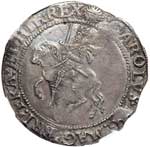 |
Great Britain. Halfcrown, ND. S.2778. Charles I, 1625-1649. Tower mint under Parliament. Mint mark sun over eye/eye (1645-46). This coin is unusual in that the I in CHRISTO is larger than the other letters. Group 3, type 3a. Struck on an ample flan with a pleasing pastel tone and a well-struck horseman. A nice example of what is normally a crudely made coin from the bleak era of England's only Civil War. NGC graded AU-50.
Estimated Value $600 - 700.
View details and enlarged photos
| Realized
$690 |
Lot 4390 |
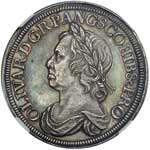 |
Great Britain. Tanners Copy Crown, 1658. S.3226B; ESC-13. Oliver Cromwell. Laureate and draped bust of Cromwell left. Reverse: Crowned shield of the Protectorate. Probably the finest surviving specimen of the few examples made. Uncirculated with a light grey and blue tone and one of the most dazzling coins in the British numismatic series.
Similar to the regular Cromwell Crown, but slightly different features are to be noted on the portrait. The top leaf of the laurel points to the first limb of N, which is itself upside down. The beading of the border is wider, there are stops after HIB and PRO, and there are flaws in all P's. The date is a sharp singular 1658, not 58/7.
English Silver Coinage designates the Tanner's copy as Rarity 4 (only 11 to 20 examples known) whereas the regular Cromwell Crown is simply described as 'scarce,' making this an irreplaceable landmark coin. NGC graded Proof 64.
*It is easy to see Cromwell as an uncompromising regicide and Charles as a dignified martyr who was misunderstood and died with great dignity. In reality, Charles the man was courteous if distant, but as a king he had a complete lack of scruples. He lied, cheated and double-crossed from start to finish. What doomed him was his failure to understand the spirit of England which Parliament to a large extent represented and which is so clearly shown in the calibre of his opponents, Pym, Hampden, Fairfax, Milton and Cromwell.
As Lord Protector Oliver Cromwell gained great prestige for himself and for his country. In his first year he made what was considered as an advantageous peace with the Dutch, in 1654 he made war with Spain. His government could not put an end to religious disorder, but it set an example of tolerance, even towards the Catholics. There began, however, an experiment in military government which served only to heighten ill-feeling all round. Eleven major-generals were put over the administration of large districts and eventually the country began to tire of Cromwell's puritanical attitudes and militaristic fervour. The second Protectorate (Cromwellian) Parliament was elected in an atmosphere of growing discontent and was so divided it seemed that the country could only be re-united under a constitutional monarch. Cromwell then became Lord Protector - a de facto king - and in 1657 he was given the right to name his successor.
In 1658 (the year this coin is dated) Oliver died and his amiable though completely unsuitable eldest son Richard replaced him, although Richard clearly did not want the job! The country had experimented and was now in the mood for the return of the monarchy in the person of the able and energetic King Charles II.
Estimated Value $23,000 - 25,000.
Ex Millennia Collection; Ex Cheshire Collection.
View details and enlarged photos
| Realized
$25,300 |
Lot 4391 |
 |
Great Britain. Halfcrown, 1658. S.-3227A; ESC-447. Oliver Cromwell. Obverse: Laureate draped bust of the Lord Protector left. Reverse: Crowned shield of the Protectorate. Edge PAX QVAERITVR BELLO. Deeply toned, prooflike mint state, and surprisingly free from scuffs, marks and scratches.
This coin has a mirror-like unblemished beauty which rivals that of any other specimen which we have seen. This is truly a paragon of seventeenth century coinage. Rare this nice. PCGS graded MS-64.
Estimated Value $9,000 - 10,000.
View details and enlarged photos
| Realized
$12,650 |
Lot 4392 |
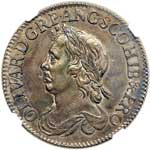 |
Great Britain. Shilling, 1658. S.3228; ESC-1005. Oliver Cromwell. Obverse: Portrait of the Lord Protector. Reverse: Crowned shield. Grained edge. A well struck coin with good surfaces and sharp detail. A popular denomination. NGC graded MS-62.
Estimated Value $4,300 - 4,800.
View details and enlarged photos
| Realized
$4,830 |
|
|